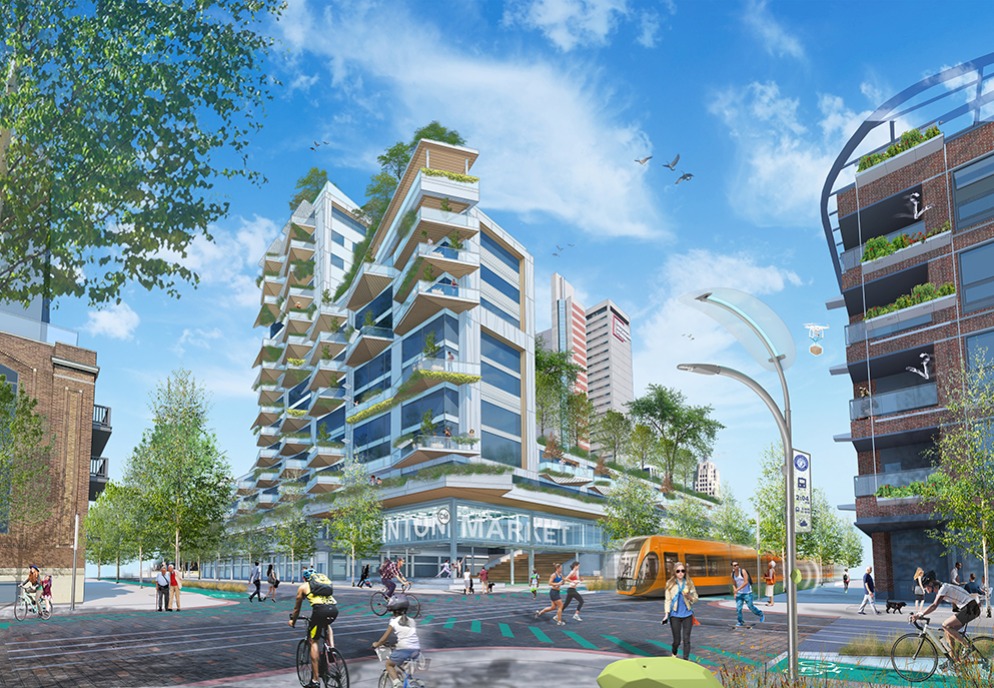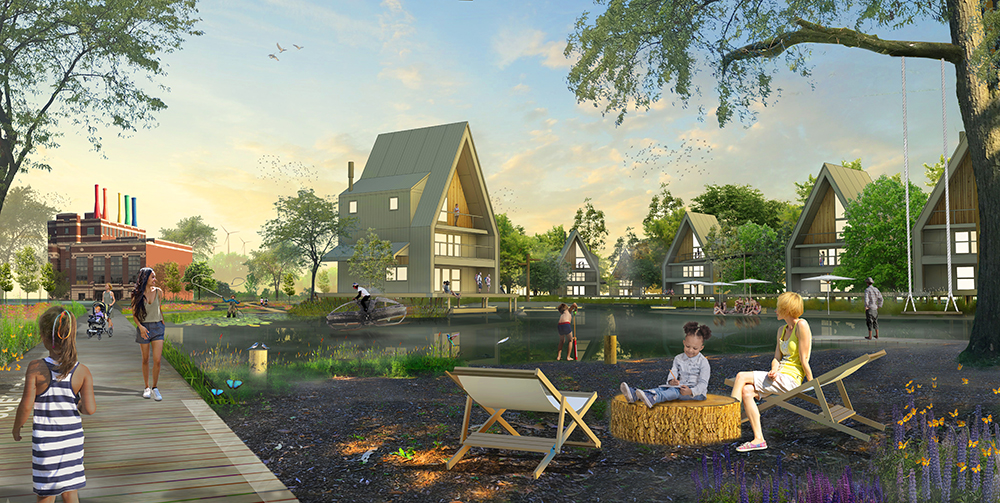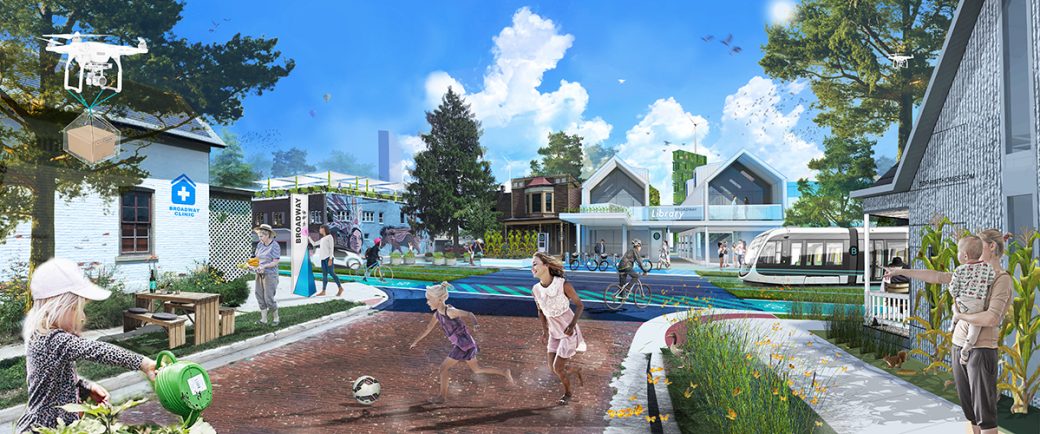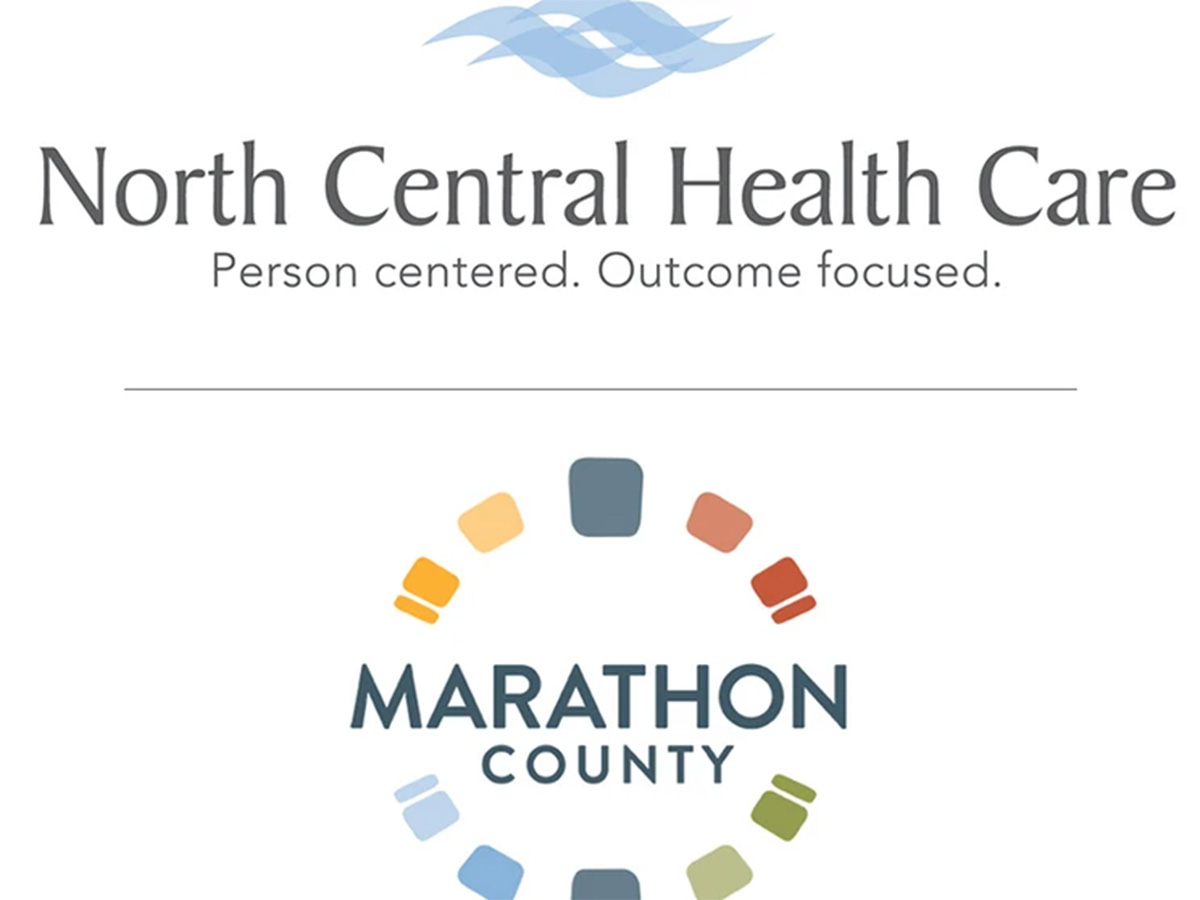MKM and Angus-Young Associates have been selected to expand and renovate the Marathon County North Central Health Care Wausau Campus.

Over the last fifteen years, downtown Fort Wayne has seen an unprecedented amount of investment.
Projects ranging from Parkview Field to the GE campus have inspired many to imagine what else our community could accomplish in the next 15 years. However, it’s a different question to ask then what the result of this effort would be? Or what quality of life we hope this progress will eventually provide?
A better question to ask is what will it be like for future generations to live in Fort Wayne? What will it take to make our downtown a thriving, livable and healthy metropolis? Or maybe more interestingly, what will it be like to call downtown Fort Wayne home in the year 2060?
These are fascinating questions, ones whose answers likely lies somewhere in the growing connection between technology and placemaking. As society’s demand for equity, accessibility, and inclusiveness continues to grow – so will our desire to manage community development at a grassroots level. The future advancements in technology likely won’t be utilized to create top-down developments of enormous scale and ambition as in previous generations. Instead, these innovations offer an opportunity for us to develop and maintain bottom-up, localized neighborhoods – places empowered by cooperative social networks focused on the health and well-being of its members.
The future provides the possibility of a new neighborhood – one that uses emerging technologies not as platforms for complicated architecture or flying cars, but as tools for developing resilient and locally-operated enclaves of families and friends. The success of these communities will be measured by their ability to allow neighbors to support one another – making the neighborhood, in all its different iterations, the guiding force for effective community development.
The trick is, this is harder than it sounds. Not only do we need to react to the current realities of the local economy, but we also, in some way, need to predict what the future may hold. That’s why the most effective strategies are those that can balance the needs of the present with the opportunities of the future. The problem is, whenever we try to predict the future, we usually get it wrong.
This isn’t because we aren’t creative enough to envision complex innovations. It’s because we struggle to understand the social context in which these advances will occur. For example, look at the relationship between technology and fashion in traditional depictions of the future. If these predictions were to be believed, it appears that everyone, from Star Trek or Star Wars, eventually gains the ability to develop amazingly complex mechanisms for transportation and communication while, at the same time, conceding to wear matching, monochromatic jumpsuits. It’s easy to fantasize about the evolution of technology. It’s much more difficult to predict how themes such as individualism, fellowship and freedom will shape our culture along the way. In dreaming about the future of our cities, we need to consider how these ideas will impact our communities, especially over long periods of time. Like any living thing, our progress is limited by the evolutionary patterns that define us.
We only get into trouble when we try to convince each other that, for some reason or another, humans are special. When it comes to understanding how a community works – we’re not much different than other animals.
If we had the ability to look at a neighborhood of people in the same disciplined manner we analyze a school of fish, we would quickly notice how the structures of our communities are a result of complex set of interrelated variables. And it’s these variables – patterns and habits – that directly influence how our communities will evolve over time.
Too often, when we talk about the future of our communities we limit the discussion to the topic of capacity. How much could we do in how little time? How much stuff could we develop in the next 10 years? Seldom do we talk about the impact our culture will have on how these ideas are received, implemented, or managed. It’s an instinct we need to resist if we are serious about looking at the future of Fort Wayne.
If we want to know what it will be like to call downtown Fort Wayne home in the year 2060, we simply can’t try to understand what our capacity for growth is between now and then. We need to begin to appreciate how the idea of “home” might evolve during that same time. How will our understanding of our home – and, by extension, our neighborhoods – change in the future?
The answer to this question will require us to start thinking differently about our community, ourselves, and the places we call home.

The Evolution of Home
The idea of home is more nuanced than most people realize. Our perception of what it means to be home isn’t as simple as locating ourselves under a specific roof.
Our sense of home is found in the overlap of three specific components: the physical structure of the house; the context surrounding its location; and the user group within its walls. Over the course of our lifetime, these three things will constantly change. Yet, where they overlap and occur in unison is what we commonly understand as home.
There is no better explanation of this phenomenon than the opening scene of Pixar’s movie Up. It’s in those first six minutes where Carl Fredricksen shows us the complex relationship we have with our homes. As the time-lapse video plays a summary of Carl’s life, we see him and his new bride begin to renovate their new house (e.g. the structure). We also see how the neighborhood is changing around him as he stubbornly refuses to sell his house (e.g. the context). And we see the effect the death of his wife has on his spirit (e.g. user group). Each change presents a new definition of home – some admittedly more pleasant than others.
What we learn from Carl’s story is something we all already know. Our homes are an extension of ourselves. Our identity, our dreams, and our aspirations are tied to the places we call home. And no matter how much they change or how much they change us, it is hard to understand a world without our home as a point of reference.
This is an important distinction, one that is unfortunately ignored when discussing the effectiveness of community development. But how can it be? What is the point of community development if it is not, at its core, an effort aimed at helping people create their own sense of home?
To support the growth of meaningful places we need to better understand how we can encourage people to develop their own stories, their own memories and their own dreams. Our future as a community, in an interesting way, hinges on our ability to recognize this.
If we take a cursory look at the progression of home over time, we will find that it is a centuries-old experiment that has always focused on this relationship between dwelling, context, and user groups.
If we are serious about forecasting what our communities might look like in the future, we need to consider how these elements will shape a new understanding of what home means to future generations. To do this, it is helpful to analyze how our sense of home has evolved over the years.
Since the 16th century, the idea of the home can be subdivided into five generalized eras. The first was the era of privacy. At the time, the average size of the family home was over 2,000 square feet and often had over 20 residents. While the homes were difficult to maintain, often requiring a variety of duties and tasks, it was here that the concept of individual privacy was born.
By introducing the idea of formal bedrooms and dining rooms into the vernacular, the first notion of the modern home began to emerge. Coincidentally, it was also where we begin to see the rise of individualism, with words like self-esteem and self-confidence entering popular culture. It is here that the connection between the house and the family unity was formalized.
The 18th and 19th centuries brought the era of comfort. As technology improved, the need for homemakers diminished – resulting in the average home of 1,700-1,900 square feet and 10-15 residents. With the notion of privacy developed, this time frame saw the segmentation of public and private spaces, compartmentalizing the home into day (downstairs) and night (upstairs) functions.
With the popularization of the front porch, the home was now a fully functioning extension of the family unit – equipped to support the daily needs of its occupants while providing them the ability to entertain guests and neighbors. As the kitchen became the central focal point of the home, large windows, spacious gardens and formal bathrooms inspired the rise of domesticity. This trend, supplemented by the influential work of contemporaries such as Jane Austin, sparked a growing interest in the connection between home and comfort.
The 20th century brought with it an obsession with productivity, classifying the time between 1900 and 1960 as an era of efficiency. With the growth of laborsaving technologies such as heating, air conditioning, and vacuum cleaners, the maintenance of the home was dramatically reduced – allowing the average size of the home to shrink to 800 square feet while now only serving four or five people. In addition to this, the Servicemen’s Readjustment Act of 1944, also known as the G.I. Bill, provided soldiers returning from World War II an opportunity to own their own home.
The rise of mass production revolutionized how we thought about the home, shaping the way they were built, managed, and marketed. Suddenly, the house became another consumer product selected out of a magazine and conveniently shipped to a location of your choosing.
As the level of home ownership rose dramatically, so did our infatuation with independence. The growth of suburban sprawl transformed the structure of communities across the country, glorifying a new model for living – the era of autonomy. Here, success was measured by what amenities we could internalize within the home.
Instead of relying on shared civic amenities, functions such as the home office, home gym, home library, and home theater became synonymous with achievement. The further we distanced ourselves from our neighbors, the more independent we assumed to be.
And for the first time in modern history, the average size of a home increased, peaking at 2,400 square feet and serving on average less than three people.
In a culmination of factors, the home had become synonymous with the American Dream – an idea that relied on the progression of interests that incorporated elements from each of the previous eras. Privacy, comfort, efficiency, and autonomy were now the equation for which we defined successful living. That was until 2008.
One of the most important lessons learned from the Great Recession was that we, as a society, could no longer confuse isolation for independence. Despite what we wanted to think, our health and well-being was a direct result of our connection to those around us. It depends on the supportive networks we had relied on for centuries and forced us to accept the fact that despite the technological advances, economic prosperity, or unprecedented growth, our current habits cannot support the quality of life so many of us desired. Isolated and alone, we quickly realized the difficulties of being a fish without a school. It was an epiphany that introduced a new mentality for community development: the era of cooperation.
As Joshua Green notes in his book, Moral Tribes: Emotion, Reason, and Gap Between Us and Them, “From simple cells to supersocial animals like us, the story of life on Earth is the story of increasingly complex cooperation. Cooperation is why we’re here, and yet, at the same time, maintaining cooperation is our greatest challenge.” If we can focus on this challenge, we will likely find a more effective way to build communities.
What we learned is that we need each other. Humans, by nature, are cooperative creatures. For thousands of years our civilizations were built on a collective concern for our community, creating rituals and practices that focused on the survival of the tribe. Only recently did we forget this and began to think that our existence was an individualistic endeavor.
It’s important to note that this new mindset does not dismiss the previous endeavors, but simply adds to the overall equation. If the future development of our cities is to be effective, we will need to understand how we can provide a quality of life that prioritizes privacy, comfort, efficiency, autonomy, AND cooperation. However, it is a problem we have limited time to solve.

Rethinking the Commons
Over the next several decades, cities throughout the country will see unprecedented demographic shifts. From Brain Drain and aging Baby Boomers, to skilled labor shortages and rising chronic disease, the American community is preparing for an undeniable series of transformations.
The quality of life of future generations will rely on a willingness to understand how this idea of cooperation redefines our approach to community development.
If we want people to call our community their home, we need to start considering how people will shape their homes into our community. It’s a discussion that hinges on our ability to trust one another.
In his book, Origins of Virtue: Human Instincts and the Evolution of Cooperation, Matt Ridley reminds us that “there has been glimpses of a better way, of a society built upon voluntary exchange of goods, information, fortune, and power between free individuals in small enough communities for trust to be built. I believe such a society could be more equitable, as well as more prosperous, than one built upon bureaucratic statism.”
Ridley goes on to say that, “If we are to recover social harmony and virtue, if we are to build back into society the virtues that made it work for us, it is vital that we reduce the power and scope of the state. That does not mean a vicious war against all. It means devolution: devolution of power over people’s lives to parishes, computer networks, clubs, teams, self-help groups, small businesses – everything small and local.” This is where the idea of the neighborhood comes in.
At their best, neighborhoods operate as an interconnected network of homes – a place that represents the collective interests of its members. Its an identity that we often undervalue. Our schools, parks and friends all exist within the geographic limits of our neighborhood. And similar to how we understand our homes, how these things work together frames our understanding of the neighborhoods in which we live.
The connection between home and neighborhood is critical factor in the success of future communities. The more dependent we are on a localized support network, the more connected we will be to our individual neighborhoods. And as our needs continue to grow, so too will our understanding of what a neighborhood can become.
There are many organizations already looking at this. Efforts such as AARP’s Livability Index or BlueZone’s Life Radius project are taking a close look at understanding how the common or shared spaces within our neighborhoods can be redefined to promote the development of an efficient support structure – one that is purposeful in serving people of all ages and abilities. To date, these strategies have been focused on municipal polices, zoning ordinance and development incentives. But soon that might change.
Emerging advancements in social media, robotic automation, telemedicine, and autonomous transportation will change the connection between people and places forever, revolutionizing the conventional notions of economic development and transforming the power of the modern neighborhood.
As technology continues to improve, the services and products it develops will only further flatten the leadership structures governing cities, equipping neighborhoods with tremendously efficient tools for communicating, networking, and collaborating at a local level. These innovations provide the ability to support neighbors in much more effective ways.
Assets like parks, plazas, and schools will be seen as more than mere community amenities, but democratizing places that foster inclusion and opportunity. If community development, at any level, can be directly managed by the local members, neighborhoods could transform into the localized support networks they were intended to be. However, to do this will require a specific attention to scale – one that encourages cooperation and trust.
The Future is Us
We are already starting to see the era of cooperation emerge in Fort Wayne. Throughout our community, grassroot initiatives are redefining the personality and experience of the city’s neighborhoods. From murals to pubs, it is no longer enough to talk about our community in the context of the larger city. We are increasingly interested in identifying with a much smaller geographic area. Instinctively, it seems, we are searching for a scale that can reflect our search for a cooperative network of trust – a dynamic that cannot afford to focus on the local, but needs to rely on the hyper-local to operate.
When we imagine the quality of life we want for families and ourselves, we aren’t satisfied with a locally-owned pub. We want the pub to be located within our neighborhood. We want to know the brewer. And we want him to live on our street. We are searching for a system of trust across all facets of the community; one that creates a unique and vibrant experience we can all share.
What’s fascinating about this concept is that, with future redevelopment efforts, this localized leadership will redefine the identity of each place, creating a mosaic of unique neighborhoods astutely aware of the needs and interests of its residents.
It’s impossible to predict the varying outcomes of this idea, but some key themes might play heavily in the impact these hyperlocal neighborhoods could have in the future.
The first factor is crowdsourcing. The common practice of virtually surveying large groups of people will soon have an enormous impact on placemaking. Social media has revolutionized the way in which we qualify products and conduct market research. As these systems become more aligned with the built environment, residents can communicate their needs and desires to their larger neighborhood, as well as have the capacity to operate their neighborhood. Personalized devices and proximity locators will not simply increase our ability to communicate with family and friends, they present an opportunity to engage the built environment in an entirely new way.
Take, for example, the epidemic of loneliness facing many communities. It is a failure of our neighborhood structure and a problem social media alone will not be able to repair. Research has shown that lonely people are 30% more likely to suffer from a stroke or heart disease. In the past, researchers thought this was simply due to fewer people noticing when a person was ill. But, just last year, Harvard University found that not having close friends was linked to the increased level of blood-clotting protein, which can cause heart attacks and strokes. What if the neighborhood could change this? What if we could begin to create communities that we dedicated to supporting the health and happiness of its residents? The local volunteerism group NeighborLink is doing this – leveraging technology to empower people to help neighbors in need.
The second component is sustainable ecosystems. With the looming results of escalating climate change as well as the growing preference for locally grown food, naturalized landscapes will become a critical component to future economic development. We already know the positive impacts quality park space can have on our well-being; however, future developments will prioritize space for recreation while also providing systems to grow food, process stormwater, and collect renewable energy. While other cities stubbornly refuse to acknowledge the impact of a changing global climate, our community could leverage our region’s connection to nature to our advantage. Purposefully developed and managed lakes and rivers could become a platform for sustainable innovations and grow the area’s identity as a future destination for modern living and ecotourism.
The third concept is incubation. With more of the neighborhood being controlled at a local level, the management of a shared commons presents a unique opportunity to leverage civic space in a meaningful way. For example, take the public library – one of the most effective forms of a shared commons in the history of western civilization. Since their inception, they have driven social mobility and provided millions of people access to an abundance of resources that improve their lives. While it has traditionally functioned as a communal collection of books, they have always served one common function. Public libraries are opportunity incubators, accessible civic platforms whose sole purpose is to elevate the quality of life for those they serve.
As the role of books in our culture continues to evolve, so will the tactics of libraries. Imagine a scenario where each neighborhood was equipped with a modern library – a communal place utilized by residents to address specific needs from skilled labor to opioid addiction within their localized area.
No one knows what the future will hold. And we can’t predict how technology will change the way in which are communities are developed. So how do we know what it will be like to call downtown Fort Wayne home in 2060? We don’t. We can only imagine.
But as we imagine, we can’t lose sight of what our home means to us. Despite the advancements in driverless cars our renewable energy – we will still have to acknowledge the connection between our identity and our homes. Nothing will fracture that relationship. As the architect, Witold Rybczynski reminds us, “The house contains our dreams, but it is also contained by them.”
The future of Fort Wayne rests in its neighborhoods. Its success will rely on our ability to shape places into shared experiences that are sincerely interested in the quality of life of their residents – of the people and families that breathe life into them.
In a magical way, the future of Fort Wayne rests in our ability to be good neighbors. Our responsibility is to try and understand how the advances in technology can empower us to be better neighbors – to allow us to support one another, to protect one another, to love one another. If we start making decisions with that in mind, it is easier to imagine what it will be like to call this place home.


